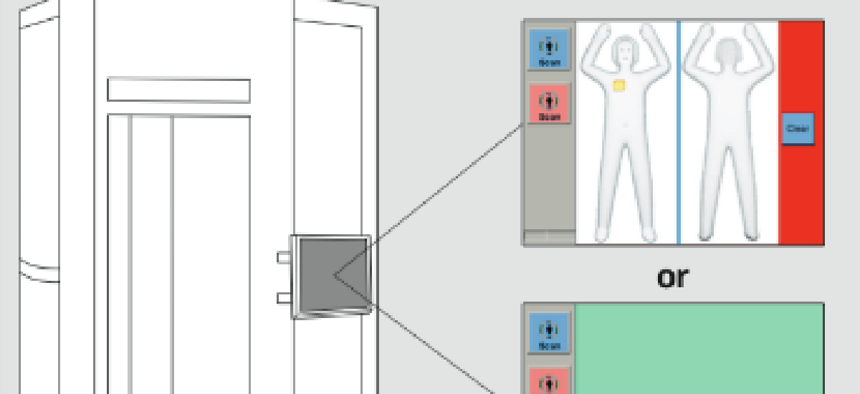GAO: TSA not making most of imaging tech

TSA is not effectively monitoring data or conducting appropriate tests of its Advanced Imaging Technology scanning machines at U.S. airports.

TSA's scanners have been equipped with Automated Target Recognition to avoid revealing passenger images, but a GAO report finds the agency is not effectively monitoring data or conducting appropriate tests of machines at U.S. airports. (Illustration from TSA.gov)
Even though the Transportation Security Administration has pushed hard to get less-intrusive security screening technology in place at the nation's airports, the agency is not fully testing it or compiling data that might help in future procurements, according to a government watchdog report.
In a report released April 30, the Government Accountability Office said TSA was not effectively monitoring data or conducting appropriate tests of its large cadre of Advanced Imaging Technology (AIT) security scanning machines, equipped with Automated Target Recognition (ATR) software at airports around the U.S.
ATR is software added to the AIT scanners a few years ago after a public outcry over previous scanner technology that produced revealing images of passengers. The ATR software helped replace those graphic images with a non-specific generic human outline, adding pointers to suspicious anomalies.
As of March 2014, according to the report, TSA has deployed about 740 machines at 160 airports. It estimated the agency will spend more than $3.5 billion over the life of the units already deployed and those it intends to buy in the future.
Despite the spending, TSA is not effectively using operational data from the systems to plan for future acquisitions, nor is it testing them effectively – largely, GAO said, because of uncertainty over what office is responsible for enforcing the machines' operation directives.
According to the report, at about half of the airports that use AIT technology, the agency does not conduct weekly checkpoint explosives detection drills with the equipment. The lack of testing and analysis, GAO said, blunts security officers' abilities to effectively and efficiently deal with the real thing.
The agency also does not track AIT false alarm rates, which could lead to further inefficiencies.
Lawmakers charged with transportation security oversight were not pleased with the findings.
"This report from GAO represents another in a long list of audits critical of TSA's acquisition and oversight of costly security-related technologies," said Rep. Bennie Thompson (D-Miss.), ranking member of the House Committee on Homeland Security, in an April 30 statement. "After failing to adequately consider the privacy implications of Advanced Imaging Technology systems before spending hundreds of millions of dollars on deploying almost 1,000 machines, we must ensure that billion dollar projects take into account proper privacy safeguards and are implemented methodically, with all available information.
"TSA should not spend a single dollar on additional AIT machines until all of the deficiencies identified in this report are resolved," he added.
A TSA spokesman declined immediate comment on the report, but pointed to the agency's official responses to GAO's recommendations for improvement.
In a lengthy response letter to GAO, DHS's GAO-Office of Inspector General Liaison Office Director Jim Crumpacker said the department was aware of the importance of the AIT systems and is working to improve testing and evaluation processes.
Crumpacker said DHS also is working in third-party collaborations with the security screening industry on developing and enhancing screening technology, and has agreed that it should revisit how checkpoint explosives drills are managed and promised to initiate a review. He also said the department has implemented security capability analysis programs to better understand the overarching security systems architecture to gain insight into its needs.
NEXT STORY: PreCheck program goes international





